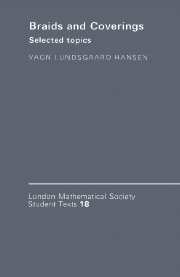Book contents
- Frontmatter
- Preface
- Contents
- Chapter I BRAIDS AND CONFIGURATION SPACES
- Chapter II BRAIDS AND LINKS
- Chapter III POLYNOMIAL COVERING MAPS
- Chapter IV ALGEBRA AND TOPOLOGY OF WEIERSTRASS POLYNOMIALS
- Appendix 1 A presentation for the abstract coloured braid group (by Lars Gæde)
- Appendix 2 Threading knot diagrams (by Hugh R. Morton), [Math. Proc. Camb. Phil. Soc. 99(1986), 247–260]
- Bibliography
- Index (to Chapters I–IV and Appendix 1)
Chapter I - BRAIDS AND CONFIGURATION SPACES
Published online by Cambridge University Press: 06 January 2010
- Frontmatter
- Preface
- Contents
- Chapter I BRAIDS AND CONFIGURATION SPACES
- Chapter II BRAIDS AND LINKS
- Chapter III POLYNOMIAL COVERING MAPS
- Chapter IV ALGEBRA AND TOPOLOGY OF WEIERSTRASS POLYNOMIALS
- Appendix 1 A presentation for the abstract coloured braid group (by Lars Gæde)
- Appendix 2 Threading knot diagrams (by Hugh R. Morton), [Math. Proc. Camb. Phil. Soc. 99(1986), 247–260]
- Bibliography
- Index (to Chapters I–IV and Appendix 1)
Summary
Braids are among the oldest inventions of mankind. They are used for practical purposes to make rope, and for decorations in weaving patterns and hairstyle etc.
As mathematical objects they were introduced by the German mathematician Emil Artin in a paper from 1925, although the idea was implicit in a paper of Hurwitz from 1891. Artin proposed to use braids to study knots and links. There are now applications of braids in several mathematical subjects: Topology (knots, links, fixed point theory, covering spaces), geometry (mapping class groups), singularity theory, dynamical systems, operator algebras, to mention a few. Such developments and many more were reported in a meeting on Artin's braid group held in Santa Cruz, July 13 to July 26, 1986, and has appeared in the conference proceedings (edited by J.S. Birman and A. Libgober) as volume 78 in the AMS Contemporary Mathematics series.
Chapter I contains the basic material on braid groups and the spaces related to them. The chapter opens with the definition of a geometric braid on n strings, first the original definition of Artin from 1925 as a system of n strings between two parallel planes in euclidean 3–space, and then the equivalent definition – suggested by Fox 1962 – as a loop in the space of configurations of a set of n points in the euclidean plane. The definition of Fox can be extended to define braids in any manifold and will prevail in the book. The fundamental system of fibrations of configuration spaces defined by Fadell and Neuwith 1962 plays an important role.
- Type
- Chapter
- Information
- Braids and CoveringsSelected Topics, pp. 1 - 48Publisher: Cambridge University PressPrint publication year: 1989



